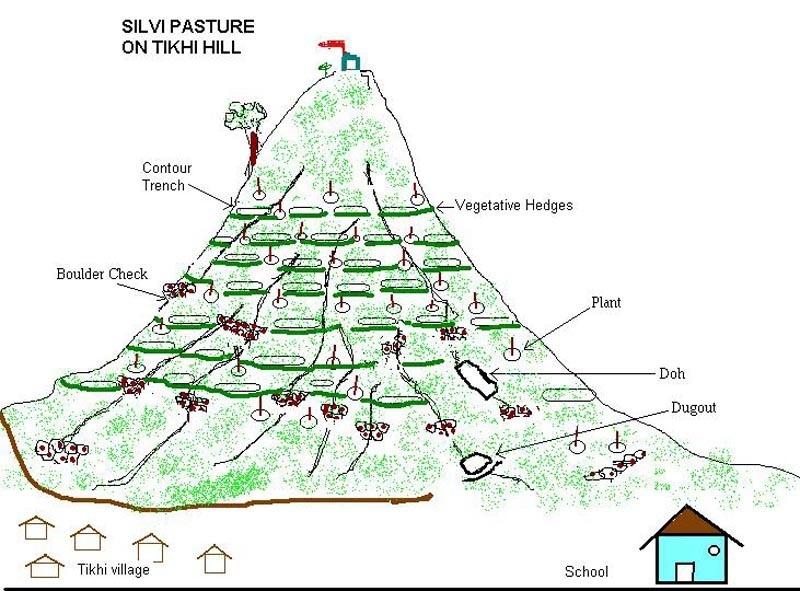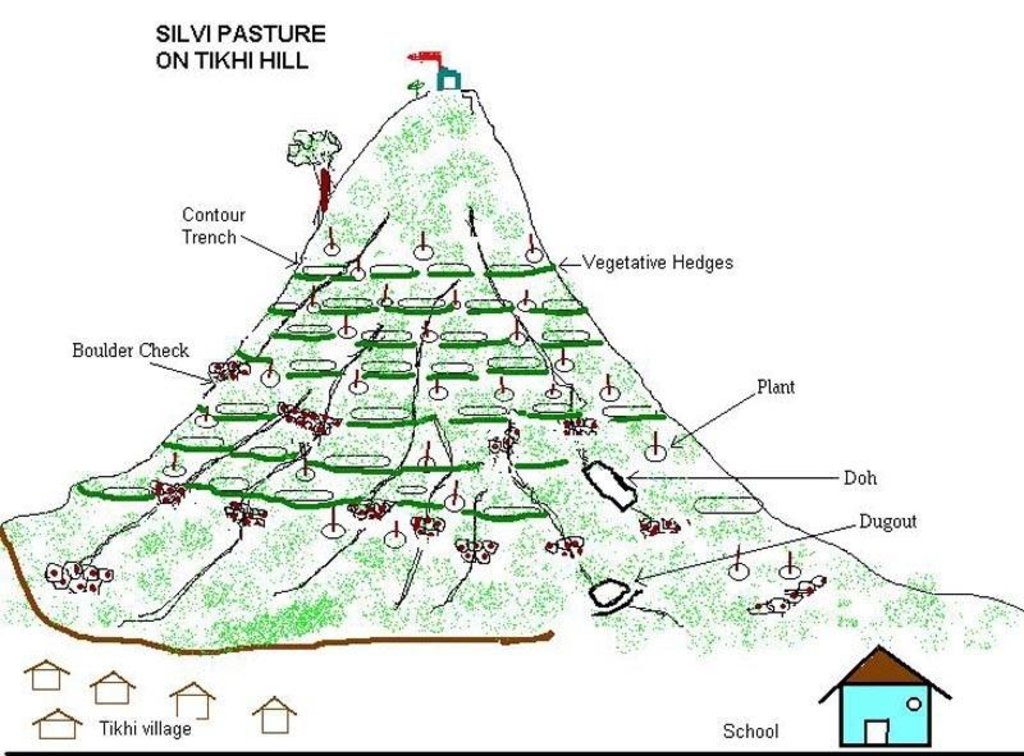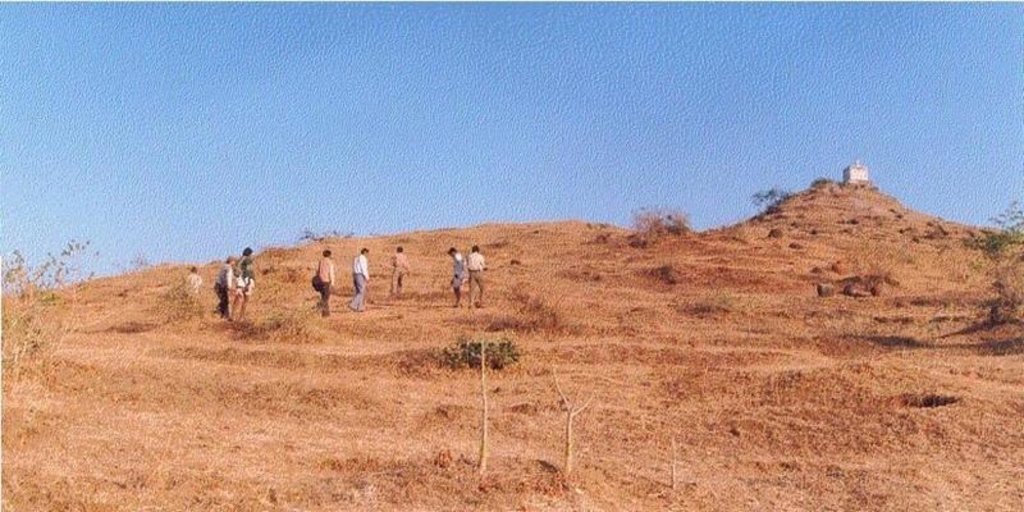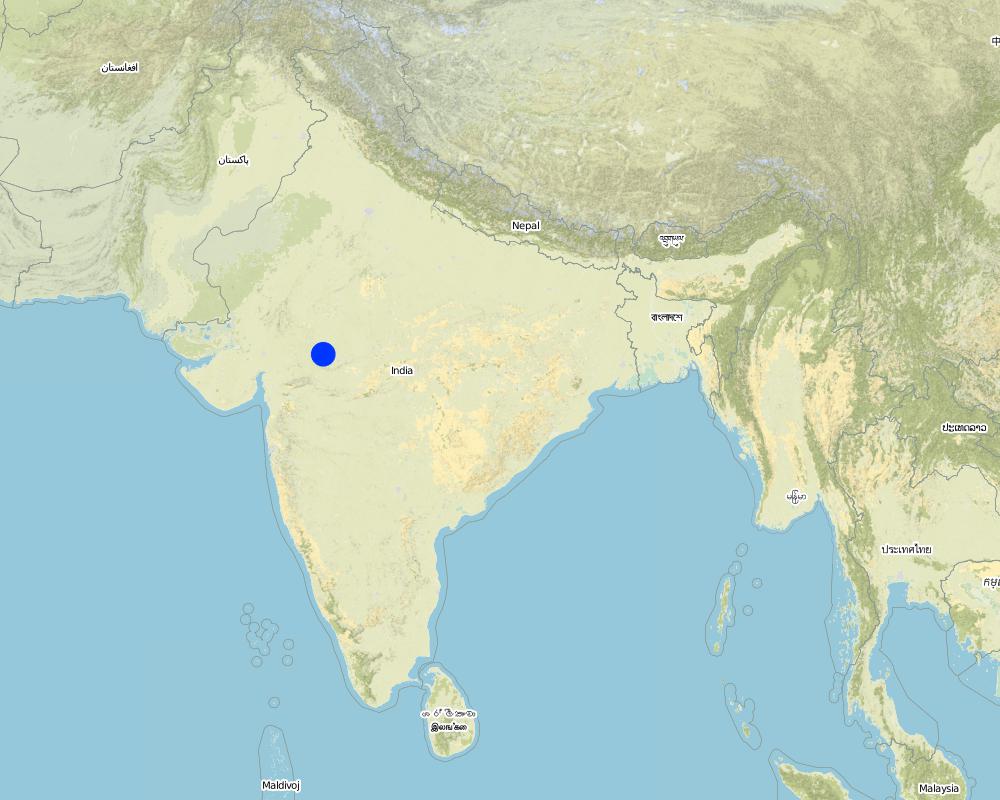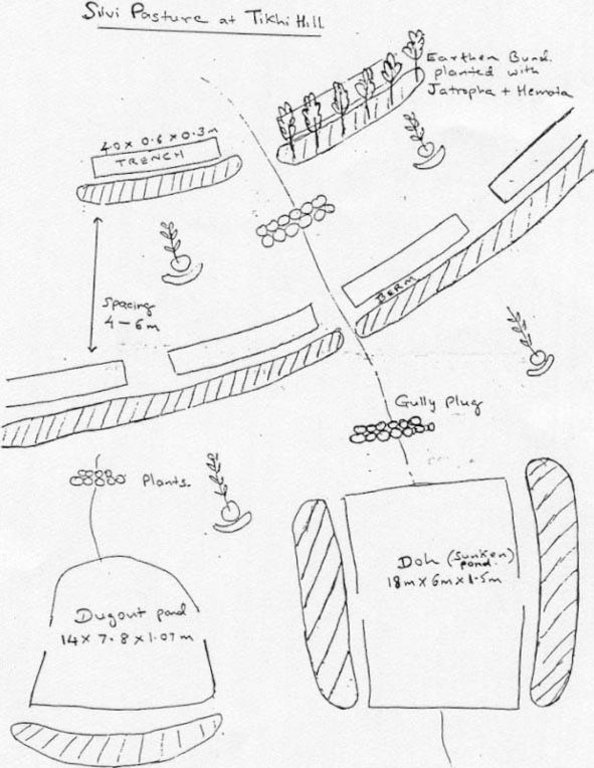Silvi Pasture [ប្រទេសឥណ្ឌា]
- ការបង្កើត៖
- បច្ចុប្បន្នភាព
- អ្នកចងក្រង៖ Unknown User
- អ្នកកែសម្រួល៖ –
- អ្នកត្រួតពិនិត្យច្រើនទៀត៖ Fabian Ottiger, Alexandra Gavilano
Nursery
technologies_1470 - ប្រទេសឥណ្ឌា
ពិនិត្យមើលគ្រប់ផ្នែក
ពង្រីកមើលទាំងអស់ បង្រួមទាំងអស់1. ព័ត៌មានទូទៅ
1.2 ព័ត៌មានលម្អិតពីបុគ្គលសំខាន់ៗ និងស្ថាប័នដែលចូលរួមក្នុងការវាយតម្លៃ និងចងក្រងឯកសារនៃបច្ចេកទេស
បុគ្គលសំខាន់ម្នាក់ (ច្រើននាក់)
អ្នកជំនាញឯកទេស SLM:
Mewara Ramesh
ប្រទេសឥណ្ឌា
1.3 លក្ខខណ្ឌទាក់ទងទៅនឹងការប្រើប្រាស់ទិន្នន័យដែលបានចងក្រងតាមរយៈ វ៉ូខេត
អ្នកចងក្រង និង(បុគ្គលសំខាន់ៗ)យល់ព្រមទទួលយកនូវលក្ខខណ្ឌនានាទាក់ទងទៅនឹងការប្រើប្រាស់ទិន្នន័យដែលបានចងក្រងតាមរយៈវ៉ូខេត:
បាទ/ចា៎
1.5 ការយោងទៅលើកម្រងបញ្ជីសំណួរ (មួយ ឬច្រើន) នៃវិធីសាស្ត្រផ្សព្វផ្សាយ SLM (ដែលបានចងក្រងដោយទស្សនៈពិភពលោកស្តីពីវិធីសាស្ត្រ និងបច្ចេកទេសងអភិរក្ស WOCAT)
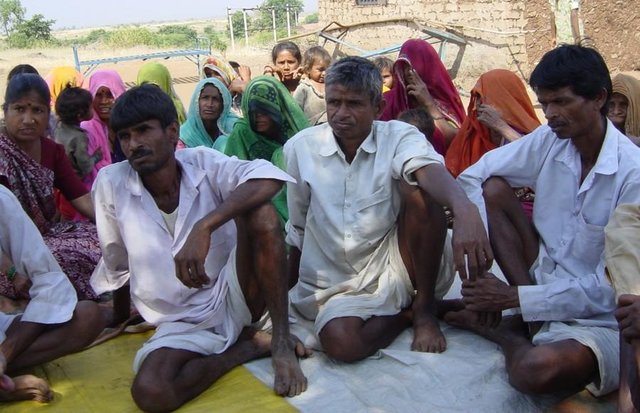
Comprehensive watershed development [ប្រទេសឥណ្ឌា]
Participatory approach that includes a package of measures leading to empowerment of communities to implement and sustain watershed development.
- អ្នកចងក្រង៖ David Gandhi
2. ការពណ៌នាពីបច្ចេកទេស SLM
2.1 ការពណ៌នាដោយសង្ខេបពីបច្ចេកទេស
និយមន័យបច្ចេកទេស:
Regeneration of degraded hill side using structural, vegetative & managerial measures.
2.2 ការពណ៌នាលម្អិតពីបច្ចេកទេស
ការពណ៌នា:
Managerial Measures : awareness generation amongst community, users groups, area closure, cut & carry system; Structural Measures :- contour trenches, gully plugs, sunken structure for run off and erosion control; Vegetative Measures :- seeding of grasses and shrubs, plantation of dryland fruit & forest tree species, vegetative barriers across slopes & gullies.
Purpose of the Technology: Short term benefits :- increased fodder availability, increase in well water levels, increased soil moisture in foot hill crop lands; Long term benefits :- environmental regeneration leading to increased production from non-arable & surrounding arable lands.
2.3 រូបភាពនៃបច្ចេកទេស
2.5 ប្រទេស/តំបន់/ទីតាំងកន្លែង ដែលបច្ចេកទេសត្រូវបានអនុវត្ត និងបានគ្រប់ដណ្តប់ដោយការវាយតម្លៃនេះ
ប្រទេស:
ប្រទេសឥណ្ឌា
តំបន់/រដ្ឋ/ខេត្ត:
Madhya Pradesh
បញ្ជាក់ពីការសាយភាយនៃបច្ចេកទេស:
- ត្រូវបានផ្សព្វផ្សាយត្រឹមតំបន់មួយ
ប្រសិនបើបច្ចេកទេសត្រូវបានសាយភាយពាសពេញតំបន់ណាមួយ បញ្ជាក់ទំហំផ្ទៃដីអនុវត្តន៍ (គិតជា គ.ម2):
79,33
ប្រសិនបើមិនច្បាស់ពីទំហំផ្ទៃដី សូមធ្វើការប៉ាន់ប្រម៉ាណ:
- 10-100 គម2
មតិយោបល់:
Total area covered by the SLM Technology is 79.33 km2.
The project area comprises 26 villages (2286 HH) mainly tribal. A significant portion of the area is uncultivable waste which is used for open grazing. The technology "Silvi-Pasture" was implemented in few villages to demonstrate an integrated system of SWC and production.
Map
×2.6 កាលបរិច្ឆេទនៃការអនុវត្ត
ប្រសិនបើមិនច្បាស់ឆ្នាំ សូមបញ្ជាក់កាលបរិច្ឆេទដែលប្រហាក់ប្រហែល:
- តិចជាង 10ឆ្នាំមុន (ថ្មី)
2.7 ការណែនាំពីបច្ចេកទេស
សូមបញ្ជាក់តើបច្ចេកទេសត្រូវបានណែនាំឱ្យអនុវត្តដោយរបៀបណា:
- តាមរយៈគម្រោង / អន្តរាគមន៍ពីខាងក្រៅ
មតិយោបល់ (ប្រភេទនៃគម្រោង ។ល។):
Learning from visits to successful watershed development projects.
3. ចំណាត់ថ្នាក់នៃបច្ចេកទេស SLM
3.1 គោលបំណងចម្បង (១ ឬច្រើន) នៃបច្ចេកទេសនេះ
- ធ្វើឱ្យប្រសើរឡើងនូវផលិតកម្ម
- កាត់បន្ថយ, បង្ការ, ស្តារឡើងវិញនូវការធ្លាក់ចុះគុណភាពដី
3.2 ប្រភេទដីប្រើប្រាស់មួយប្រភេទ (ច្រើនប្រភេទ) ដែលបានអនុវត្តបច្ចេកទេស
ដីប្រើប្រាស់ចម្រុះនៅលើដីតែមួយ:
បាទ/ចា៎
បញ្ជាក់ពីប្រភេទដីច្រើនប្រភេទ (ដីដាំដំណាំ/ដីចិញ្ចឹមសត្វ/ដីព្រៃឈើ):
- ដីព្រៃឈើ និងដីចិញ្ចឹមសត្វ

ដីដាំដំណាំ
- ដំណាំប្រចាំឆ្នាំ
- ប្រភេទដើមឈើធំៗ និងដើមឈើតូចៗ
ដំណាំប្រចាំឆ្នាំ - បញ្ជាក់ប្រភេទដំណាំ:
- ដំណាំចំណីសត្វ - ស្មៅ
ប្រភេទដើមឈើធំៗ និងដើមឈើតូចៗ - បញ្ជាក់ប្រភេទ:
- ផ្លែឈើផ្សេងៗ
ចំនួនសារដែលដាំដំណាំក្នុងមួយឆ្នាំ:
- 2
សូមបញ្ជាក់:
Longest growing period in days: 120 Longest growing period from month to month: Jun - Oct Second longest growing period in days: 120 Second longest growing period from month to month: Nov - Mar

ដីសម្រាប់ចិញ្ចឹមសត្វ
ដីវាលស្មៅតូចៗ/ ផលិតកម្មចំណី:
- កាត់ និងជញ្ជូន/ គ្មានវាលស្មៅសម្រាប់ចិញ្ចឹមសត្វ

ដីព្រៃ/ដីដាំដើមឈើ
ប្រភេទឈើ:
- Azadirachta indica
- Jatropha, Salai (cf. Boswellia serrata), Lantana
មតិយោបល់:
Major land use problems (compiler’s opinion): Grass land :- Degradation due to over grazing; Crop Land :- Low yeilds due to erosion, low soil moisture, improper cultivation practices on sloping lands.
Major land use problems (land users’ perception): Low yields of grass and crops
Trees/ shrubs species: Jatropha, Salai, Neem (Azadirachta indica), Lantana
Fruit trees / shrubs species: Awla (goose berry)
Grass species: Stylo Hemata, Dicanthus(Dinanath)
3.4 ការផ្គត់ផ្គង់ទឹក
ការផ្គត់ផ្គង់ទឹកនៅកន្លែងអនុវត្តបច្ចេកទេស:
- ទឹកភ្លៀង
មតិយោបល់:
Water supply: Also mixed rainfed - irrigated
3.5 ក្រុម SLM ដែលបច្ចេកទេសស្ថិតនៅក្នុង
- តំបន់ទ្រនាប់ (បិទការប្រើប្រាស់ គាំទ្រដល់ការស្តារឡើងវិញ)
- វិធានការអនុវត្តកាត់ទទឹងទីជម្រាល
- ការគ្រប់គ្រងទឹកលើដី (ទឹកធ្លាក់ ទន្លេ បឹង សមុទ្រ)
3.7 កំណត់ប្រភេទនៃការធ្លាក់ចុះគុណភាពដីសំខាន់ៗដែលបច្ចេកទេសនេះបានដោះស្រាយ

ការហូរច្រោះដីដោយសារទឹក
- Wt: ការបាត់ដីស្រទាប់លើដោយការហូរច្រោះ
- Wg: ការកកើតឡើងនូវកំទេចកំទីដីស្រទាប់ក្រោម

ការបាត់បង់ទឹក
- Ha: ការថយចុះសំណើមដី
មតិយោបល់:
Main type of degradation addressed: Wt: loss of topsoil / surface erosion
Secondary types of degradation addressed: Wg: gully erosion / gullying, Ha: aridification
Main causes of degradation: other human induced causes (specify) (Social causes - Lack of awareness and mobilisation amongst the communities.), Top down approach (Macro planning rather than micro (village level) planning.)
4. បច្ចេកទេសជាក់លាក់ សកម្មភាពអនុវត្ត ធាតុចូល និងថ្លៃដើម
4.1 គំនូសបច្ចេកទេសនៃបច្ចេកទេសនេះ
លក្ខណៈពិសេសនៃបច្ចេកទេស (ទាក់ទងនឺងគំនូរបច្ចេកទេស):
Technical Drawing of SWC technology area, Tikhipada
Technical knowledge required for field staff / advisors: moderate
Technical knowledge required for land users: moderate
Main technical functions: control of dispersed runoff: retain / trap
Secondary technical functions: control of raindrop splash, control of concentrated runoff: retain / trap, control of concentrated runoff: impede / retard
Trees/ shrubs species: Jatropha, Salai, Neem, Lantana
Fruit trees / shrubs species: Awla (goose berry)
Grass species: Stylo Hemata, Dicanthus(Dinanath)
Slope (which determines the spacing indicated above): 35.00%
Construction material (earth): Excavation of earth for trenches/ditchs/pans
Construction material (stone): Stone plugs in gullies
Construction material (other): Vegetative support to stone plugs & ditches
Slope (which determines the spacing indicated above): 35%
Vegetation is used for stabilisation of structures.
Change of land use type: land use planning - Silvi Pasture
Change of land use practices / intensity level: land use change - Area Closure
Control / change of species composition: livestock management - Cut & carry system
Other type of management: Management by community( User Group)
ឈ្មោះអ្នកនិពន្ធ:
David Gandhi
4.2 ព័ត៌មានទូទៅដែលពាក់ព័ន្ធនឹងការគណនាធាតុចូល និងថ្លៃដើម
ផ្សេងៗ/ រូបិយប័ណ្ណជាតិ (បញ្ជាក់):
Rupees
បើពាក់ព័ន្ធសូមកំណត់អត្រាប្តូរប្រាក់ពីដុល្លាទៅរូបិយប័ណ្ណតំបន់ (ឧ. 1 ដុល្លារ = 79.9 រៀលនៃរូបិយប័ណ្ណប្រេស៊ីល) ៖ 1 ដុល្លារ =:
48,85
កំណត់ថ្លៃឈ្នួលជាមធ្យមនៃការជួលកម្លាំងពលកម្មក្នុងមួយថ្ងៃ:
1.00
4.3 សកម្មភាពបង្កើត
| សកម្មភាព | រយៈពេល (រដូវកាល) | |
|---|---|---|
| 1. | Digging of plantation pit | Summer |
| 2. | Procurement of seeds, plants | Before rainy sesion |
| 3. | Sowing of grass & shrub seeds | Before Ist shower |
| 4. | Planting of saplings | After Ist heavy shawer |
| 5. | Survey/Layout | April (summer) |
| 6. | Excavation of ditches | May |
| 7. | Transportation of stones to site | May |
| 8. | Construction of sediment/sand trap | May |
| 9. | Excavation of Pan(Doh) | May 2nd year |
| 10. | Discussion with community & exposure visit | Feb |
| 11. | Formation of users group, meeting, preparation of action plan | March |
| 12. | Establishment of structural measures & training of users group | April-Jun |
| 13. | Establishment of vegetative meassures | July-Sep. |
| 14. | Area Closure | April-Oct. |
| 15. | Harvesting & distribution of grass by users group | Oct.-Nov. |
4.4 ថ្លៃដើម និងធាតុចូលដែលត្រូវការសម្រាប់ការបង្កើតបច្ចេកទេស
មតិយោបល់:
Duration of establishment phase: 24 month(s)
4.5 សកម្មភាពថែទាំ
| សកម្មភាព | ពេលវេលា/ ភាពញឹកញាប់ | |
|---|---|---|
| 1. | Weeding , mulching | 2-3 month after planting /Twice in year for Ist 2 year |
| 2. | Watering | Dry season /During prolonged dry spells |
| 3. | Reseeding of grass/shrubs | Before Ist shower /Upto 2 years |
| 4. | Casualty replacement | After Ist heavy shower /Year 1 & II |
| 5. | Repair of breaches in ditches/traps | July-Sep. during mansoon/As required |
| 6. | Construction of additional traps | July-Sep. during mansoon/As required |
| 7. | Desilting of Ditches/traps/Pans | Oct.-Nov. after mansoon/Annually |
| 8. | Refresher training of users group | Seasonally / |
| 9. | Regular meeting of users group | / 3 times/year |
| 10. | "Shramdan" ( Voluntary labour by usersfor maintenance) |
4.6 កំណត់ថ្លៃដើមសម្រាប់ការថែទាំ/ សកម្មភាពរបស់បច្ចេកទេស (ក្នុងរយៈពេលមួយឆ្នាំ)
មតិយោបល់:
The treatment covered an area of aroung 10 ha. 1- Contour Trenches - 6000 Rmt. 2- Large Boulder Check - 58 3- Small Boulder Check - 55 4- Dugout - 1 No. 5- Doh - 1 No. Seeding with jatropha, stylo and dinanath. Planting of saplings.
4.7 កត្តាសំខាន់បំផុតដែលមានឥទ្ធិពលដល់ការចំណាយ
ពណ៌នាពីកត្តាប៉ះពាល់ចម្បងៗទៅលើថ្លៃដើម:
1- Slope : - Due to steep slope , interval between contour trench lines was less; 2- Soil Depth : - Due to stony strata, excavation cost was high; 3- Material : - Boulders were transported from outside. 4- Lead/Lift : - Due to steep slope, labour output was less 5- Drought :- Replantation costs were high
5. លក្ខណៈបរិស្ថានធម្មជាតិ និងមនុស្ស
5.1 អាកាសធាតុ
បរិមាណទឹកភ្លៀងប្រចាំឆ្នាំ
- < 250 មម
- 251-500 មម
- 501-750 មម
- 751-1,000 មម
- 1,001-1,500 មម
- 1,501-2,000 មម
- 2,001-3,000 មម
- 3,001-4,000 មម
- > 4,000 មម
កំណត់បរិមាណទឹកភ្លៀង (បើដឹង) ជា មីលីម៉ែត្រ:
800,00
លក្ខណៈពិសេស/ មតិយោបល់លើរដូវភ្លៀង:
However during 1999 to 2002 below average
តំបន់កសិអាកាសធាតុ
- មានភ្លៀងតិចតួច
- ស្ងួត
Semi arid (ranked1)
Arid (ranked 2, due to 3 years of below avg. rainfall, signs of desertification eg. thorny species, lowering of water levels in wells are apparent)
5.2 សណ្ឋានដី
ជម្រាលជាមធ្យម:
- រាបស្មើ (0-2%)
- ជម្រាលតិចតួច (3-5%)
- មធ្យម (6-10%)
- ជម្រាលខ្ពស់បន្តិច (11-15%)
- ទីទួល (16-30%)
- ទីទួលចោត (31-60%)
- ទីទួលចោតខ្លាំង (>60%)
ទម្រង់ដី:
- ខ្ពង់រាប
- កំពូលភ្នំ
- ជម្រាលភ្នំ
- ជម្រាលទួល
- ជម្រាលជើងភ្នំ
- បាតជ្រលងភ្នំ
តំបន់តាមរយៈកម្ពស់ :
- 0-100 ម
- 101-500 ម
- 501-1,000 ម
- 1,001-1,500 ម
- 1,501-2,000 ម
- 2,001-2,500 ម
- 2,501-3,000 ម
- 3,001-4,000 ម
- > 4,000 ម
មតិយោបល់ និងបញ្ចាក់បន្ថែមអំពីសណ្ឋានដី :
Landforms: Hill slopes (ranked 1) and ridges (ranked 2, isolated hillcock)
Slopes on average: Steep (ranked 1, conical Shaped hillock - upper slope > 30%) and hilly (ranked 2, conical Shaped hillock - lower slope < 30%)
5.3 ដី
ជម្រៅដីជាមធ្យម:
- រាក់ខ្លាំង (0-20 សម)
- រាក់ (21-50 សម)
- មធ្យម (51-80 សម)
- ជ្រៅ (81-120 សម)
- ជ្រៅខ្លាំង (> 120 សម)
វាយនភាពដី (ស្រទាប់លើ):
- គ្រើម/ មានពន្លឺ (ខ្សាច់)
សារធាតុសរីរាង្គនៅស្រទាប់ដីខាងលើ:
- ទាប (<1%)
បើអាចសូមភ្ជាប់ការពណ៌នាពីដីឱ្យបានច្បាស់ ឬព័ត៌មានដែលអាចទទួលបាន ឧ. ប្រភេទដី, pH ដី/ ជាតិអាស៊ីត, សមត្ថភាពផ្លាស់ប្តូរកាចុង, វត្តមាននីត្រូសែន, ភាពប្រៃ ។ល។:
Soil depth on average: Very shallow (highly eroded surface, exposed parent rock)
Soil texture: Coarse/light (weathered fragments(Kopra))
Soil fertility: Very low (absence of soil)
Topsoil organic matter: Low (absence of vegetation)
Soil drainage/infiltration: Poor (high runoff from stony surface)
Soil water storage capacity: Very low (high runoff from stony surface)
5.6 លក្ខណៈនៃអ្នកប្រើប្រាស់ដីដែលអនុវត្តបច្ចេកទេស
ចំណូលក្រៅកសិកម្ម:
- 10-50% នៃចំណូល
កម្រិតជីវភាព:
- មិនល្អខ្លាំង
- មិនល្អ
សូមបញ្ជាក់ពីលក្ខណៈពាក់ព័ន្ធផ្សេងទៀតអំពីអ្នកប្រើប្រាស់ដី:
Population density: 50-100 persons/km2
18% of the land users are average wealthy (4 H.H.).
59% of the land users are poor (13 H.H.).
23% of the land users are poor (5 H.H.).
Off-farm income specification: Around 10% of the total income is from paid labour/migration
5.8 ភាពជាម្ចាស់ដី កម្មសិទ្ធប្រើប្រាស់ដី និងកម្មសិទ្ធប្រើប្រាស់ទឹក
ភាពជាម្ចាស់ដី:
- ភូមិ
កម្មសិទ្ធិប្រើប្រាស់ដី:
- ជាក្រុម (មានដែនកំណត់)
6. ផលប៉ះពាល់ និងការសន្និដ្ឋាន
6.4 ការវិភាគថ្លៃដើម និងអត្ថប្រយោជន៍
តើផលចំណេញ និងថ្លៃដើមត្រូវបានប្រៀបធៀបគ្នាយ៉ាងដូចម្តេច (ទស្សនៈរបស់អ្នកប្រើប្រាស់ដី)?
រយៈពេលខ្លី:
អវិជ្ជមាន
រយៈពេលវែង:
វិជ្ជមាន
តើផលចំណេញ និងការថែទាំ/ ជួសជុលត្រូវបានប្រៀបធៀបគ្នាយ៉ាងដូចម្តេច (ទស្សនៈរបស់អ្នកប្រើប្រាស់ដី)?
រយៈពេលខ្លី:
វិជ្ជមានតិចតួច
រយៈពេលវែង:
វិជ្ជមាន
6.5 ការទទួលយកបច្ចេកទេស
មតិយោបល់:
15% of land user families have adopted the Technology with external material support
340 land user families have adopted the Technology with external material support
Comments on acceptance with external material support: survey results
There is a little trend towards spontaneous adoption of the Technology
Comments on adoption trend: Elemets of the technology have been adopted by land users eg. SWC, grass improvement. There is tremendous pressure on grass land due to large number of local cattle & goats, migratory herds of camel & sheeps. Hence spontaneous adoption is not observed since community mobilisation is essential as also efforts for user rights.
7. ឯកសារយោង និងវេបសាយ
7.1 វិធីសាស្ត្រ/ ប្រភពនៃព័ត៌មាន
ការតភ្ជាប់ និងម៉ូឌុល
ពង្រីកមើលទាំងអស់ បង្រួមទាំងអស់ការតភ្ជាប់

Comprehensive watershed development [ប្រទេសឥណ្ឌា]
Participatory approach that includes a package of measures leading to empowerment of communities to implement and sustain watershed development.
- អ្នកចងក្រង៖ David Gandhi
ម៉ូឌុល
គ្មានម៉ូឌុល


